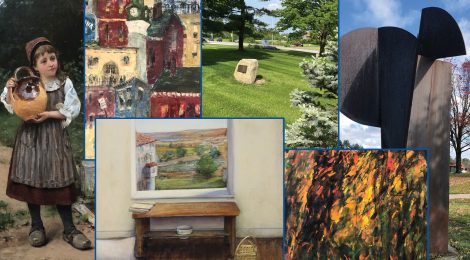
Art@ThomasMore – The William S. Bryant Arboretum
Judy Crist: Welcome to another episode of Art at Thomas More, an initiative designed to shed light on the amazing artwork and artifacts that are part of Thomas More University’s permanent collection. My name is Judy Crist, I’m a creative services director here, and for today’s episode we’ll focus on the living art found throughout campus which grows as part of the William S. Bryant Arboretum. Nature is a living, breathing form of art that not only provides the materials that artists use in the creative process but also serves as a source of inspiration. Poet Philip James Bailey once said, “Art is man’s nature; nature is God’s art.” And who can forget Vincent Van Gogh, artist extraordinaire who said, “If you truly love nature, you will find beauty everywhere.”
We spoke to Professors Shannon Galbraith-Kent and JT Spence about their involvement with the arboretum, its history, and the different plants that make up the variety of this permanent yet constantly changing form of art on Thomas More campus.
Shannon Galbraith-Kent (SGK): Hey everybody, I’m Dr. Shannon Galbraith Kent, professor in the Department of Biological Sciences here at Thomas More University.
JT Spence (JTS): and I’m JT Spencer, a professor of political science, in the College of Arts and Sciences,
SGK: and the arboretum was established in 2009 in honor of retiring emeritus professor, Dr. William S. Bryant, who taught in the biology program for 37 years. It was done to honor him as a living laboratory, basically, for on campus of all the woody plants which include trees and shrubs. Here on campus, we are able to use that with our science students, but we also host on campus walks in the fall in the spring and we also plant a lot of trees. When we started working with that, we got connected with JT and his family and their desire to have a legacy connected to their families, so it’s a nice synergy between both our academic programs and outreach to the community, as well as a connection with a faculty member’s family.
JTS: Yeah, so we planted our first tree up here in Arboretum in 2009 which was the year that the Arboretum was dedicated. We had been planting trees up in Devou Park. We taught our children about the ability to plant trees and make a legacy, and to experience what it was like to work in gardens and things like that when you’re growing up. We had trees that they helped us plant in Devou Park. When I became full time faculty are in 2009, we brought our Christmas trees. We buy live Christmas trees and we’d bring them up here, and Shannon would instruct us where to plant them. So every year our family came up here and started adding trees to the Arboretum.
SGK: Over time, connecting with JT’s family, and then again with our department and advertising, we’d have walks that have highlighted not only the trees but also birds that are on campus, also the stream ecology, with the stream that is on the back side of campus behind Murphy Hall and since 2009 we’ve planted over 25 trees. On campus, all across the campus, we have over 30 different species of trees. It’s a nice example for the campus community, as well as the broader community, that you can have lots of biodiversity in the suburbs. You don’t have to go far away, these places have extremely great ecological and educational value.
JTS: There’s a community aspect to it, as our friends found out that we planted trees up at Thomas More, they started to participate with us. We actually had visitors from Europe who are staying with us when we planted the Christmas tree and they came out here and wanted to participate as well. And students have helped us; as I’ve gotten a little older, I’m a little slower with the shovel and Shannon’s had students actually volunteer to help us plant some of our trees up here. Next year we talked to Shannon about purchasing three trees, local specimens – hardwoods, which are a little more difficult to have for Christmas trees. We want to make a contribution of that too.
SGK: We have outreach with students, with current faculty and staff, and folks from the community.
JTS: I’ll bet what Shannon is trying to say is that she’d like to have a problem where there are too many trees to plant, because then it would show everyone about how much we’re participating and creating a really viable and exciting Arboretum.
SGK: Even before the Arboretum was officially established in honor of Dr. Bryant. The Biology Club was planting trees and putting rocks identifying and commemorating different graduating classes and even before that, the connection with the community was already established too.
JTS: The Spore family really made a lot of contributions to the gardens here. I used to go between classes and I would see Mrs. Spore on her hands and kneew working in the gardens around some of the buildings on campus.
Judy Crist: Do you have information or a story about artwork on the Thomas More University campus? If you do, please contact Judy Crist at [email protected], or call 859-344-3443.

Comments are closed, but trackbacks and pingbacks are open.